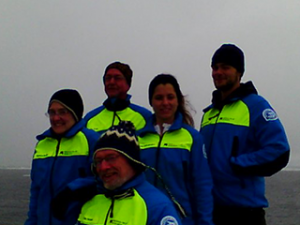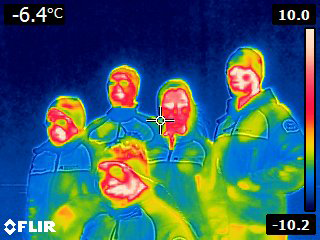29 August 2014, by Dan Wolfe:
 Meet the Boundary-Layer Meteorological Team for Leg 2 of the Arctic Cloud in Summer Experiment-2014 cruise. In the very front we have Ola Persson. From left to right behind Ola we have Barbara Brooks, Dan Wolfe, Georgia Sotiropoulou, and John Pyrthrech.
Meet the Boundary-Layer Meteorological Team for Leg 2 of the Arctic Cloud in Summer Experiment-2014 cruise. In the very front we have Ola Persson. From left to right behind Ola we have Barbara Brooks, Dan Wolfe, Georgia Sotiropoulou, and John Pyrthrech.
Ola Persson: “Private Swedish Food and Culture Guide” is a seasoned Arctic researcher with NOAA’s ESRL/PSD/Weather and Climate Physics Branch out of Boulder, CO and team leader for the Boundary-Layer Meteorology Team. His specific interests are in the interactions between the atmosphere, ocean and sea ice along the ice edge, or marginal ice zone, including those associated with clouds, mesoscale dynamics, and ocean waves. As team leader he is responsible for making sure that our scientific interests continue to be met throughout the cruise. Ola was born in Sweden moving to the US at the age of 8, though his home in the U.S. had very strong Swedish flavor to it. He has returned numerous times to Sweden to visit relatives and work for periods of a few months to a few years. His Arctic interests began with a summer job he had working as a field assistant at the University of Stockholm’s Tarfala glaciology station in northern Sweden, where he made surface radiation, mass balance, and runoff measurements on the glaciers. This job was arranged for him by Bert Bolin, a famous Swedish meteorologist who has given his name to the research center in Stockholm and who was a former folkdance partner of Ola’s mother. Besides being a great liaison he has provided us with some insights to the crew and things that are foreign to the rest of us.
Barbara Brooks: “Master of Soundings” is from the UK’s National Centre for Atmospheric Science (NCAS) and is based at the University of Leeds, UK. She’s got fingers in a number of instrument pies, primarily the atmospheric sounding system, LiDAR, and Radiometer, but is also helping out in the running of the Leeds flux mast and WAVERIDER buoy. In her spare time she is also baby-sitting the methane measuring system from Stockholm University that ran on the first leg. Her husband Ian Brooks, also with Leeds, was on the “Met Team” for leg 1. They managed to say quick hello during the crew change over in Barrow before heading in opposite directions. This is the first time she’s actually sailed on the ODEN: during the 2008 ASCOS project she had instrumentation deployed on the ship but spent the project flying over the ship in NASA’s DC8 research aircraft along with Ola as part of the AMISA project.
John Prytherch: “Flux flummuxer” is a postdoc scientist at Leeds University in the UK, working for Ian Brooks, who was on the Met Team for leg 1. This is his first time in the Arctic. He’s previously been South on a hydrographic section from the Falkland Islands to the British Antarctic base Rothera, and is pleased to get to visit both ends of the world, though sadly not the poles (unless things on Oden go badly wrong so he says…). His main responsibility on ACSE / SWERUS-C3 is the air-sea flux mast on Oden’s bow, making use of his scientific background in directly measured air-sea fluxes. As a sort of hybrid oceanographer/meteorologist, he also deploys the WAVERIDER buoy when conditions allow, launches the occasional radiosonde and helps out Barbara and the others with their various systems. John also has a blog you may be interested in following.
Georgia Sotiropoulou: “Athena of the Arctic” is a PhD student at the Department of Meteorology, Stockholm University. Born in Athens, Greece she got her bachelor degree in Physics and master degree in Environmental Science at the National and Kapodistrian University of Athens. She moved to Stockholm two years ago to study the Arctic boundary layer and Arctic clouds. This is her first time in the Arctic and first time involved in field work! On Oden, she is responsible for the weather station, the T/RH sensors and the sonic anemometer deployed on the mast, while launching radiosondes twice per day. Georgia says launching weather balloons is her favorite task.
Dan Wolfe: “Grandfather of the BAO”, though semi-retired, volunteered for this research cruise with the desire to explore a part of the Arctic he’d never seen. As described in his bio earlier in this blog he first came to the Arctic in 1970 on board the U.S. Coast Guard Icebreaker Glacier as part of WEBSEC, a baseline study in the Western Beaufort Sea prior to the Alaska pipeline. It is this adventure that encouraged him to begin a career in meteorology first with NOAA and now halftime for NOAA through the Cooperative Institute for Research in Environmental Science at the University of Colorado. This is the 4th icebreaker he has been on. He sees this as a chance to launch one more, and what could be his last, weather balloon in the same environment he launched his first!!! For those of you who don’t know, BAO stands for the Boulder Atmospheric Observatory. He has been a part of this research facility and its 300m tower located near Boulder, CO since its inception in 1977 and kiddingly referred to as its grandfather by a number of his much younger colleagues.
Our scientific goals are similar to those for Leg 1 described by Matt Shupe in his blog on July 12, but there are some important differences. Our track will be further out on the continental shelf in deeper water and the timing of our journey should include the refreezing of the ice. The surface of the ice stops melting and begins to refreeze in late August, while the bottom and sides of the sea ice continue melting until mid-September. There are signs that the melt-ponds on the surface of the ice where we are now are starting to refreeze. The average date of minimum sea-ice extent in the Arctic is Sept 15.
At right is an IR/thermal image matching the team picture as we stood out in the cold. Even though this picture is more of a fun experiment, the IR camera has a real scientific purpose and is part of an educational outreach program Matt Shupe conducts back in Colorado with local schools. If you remember Matt’s luggage didn’t make it to the ship before they departed and this was one of the items left behind. I hope to gather some interesting data for Matt including what kind of thermal image do polar bears and walrus project?
is an IR/thermal image matching the team picture as we stood out in the cold. Even though this picture is more of a fun experiment, the IR camera has a real scientific purpose and is part of an educational outreach program Matt Shupe conducts back in Colorado with local schools. If you remember Matt’s luggage didn’t make it to the ship before they departed and this was one of the items left behind. I hope to gather some interesting data for Matt including what kind of thermal image do polar bears and walrus project?
As the blog writer I’d like to say a little bit more about my fellow Arctic explorers. It’s been not quite 2 weeks and I feel like we already have great chemistry. Everyone is cheerful and willing to pitch in making things so much easier. After the work it’s fun to socialize whether it’s enjoying a “Pint” together or a friendly game of Ping-Pong (Pingis to the Swedes). I’m learning a lot about the Swedish and British and look forward to better understanding their humor and slang over the next 5 weeks. You can’t say enough having shipmates like these on such a long far away expedition!
